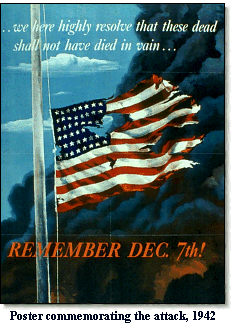
The soon to be enemy launched his planes in three waves from their carriers 200 miles north of their target. In all, the aircraft participating in the operation included 81 fighters, 135 dive bombers, 104 horizontal bombers, and 40 torpedo bombers. The plan to hit the target was divided into five distinct phases:
Phase I: Combined torpedo plane and dive bomber attacks lasting from 7:55 a. m. to 8:25 a. m.
Phase II: Lull in attacks lasting from 8:25 a. m. to 8:40 a. m.
Phase III: Horizontal bomber attacks extending from 8:40 a. m. to 9:15a. m.
Phase IV: Dive bomber attacks between 9:15 a. m. and 9:45 a. m.
Phase V. Warning of attacks and completion of raid after 9:45 a. m.
By the end of the attack on the U.S. Navy base at Pearl Harbor, O'ahu, Hawai'i on December 7th, 1941, the U.S. had paid a fearful price:
Twenty-one ships of the U.S. Pacific Fleet were sunk or damaged: the battleships USS Arizona (BB-39), USS California (BB-44), USS Maryland (BB-46), USS Nevada (BB-36), USS Oklahoma (BB-37), USS Pennsylvania (BB-38), USS Tennessee (BB-43) and USS West Virginia (BB-48); cruisers USS Helena (CL-50), USS Honolulu (CL-48) and USS Raleigh (CL-7); the destroyers USS Cassin (DD-372), USS Downes (DD-375), USS Helm (DD-388) and USS Shaw (DD-373); seaplane tender USS Curtiss (AV-4); target ship (ex-battleship) USS Utah (AG-16); repair ship USS Vestal (AR-4); minelayer USS Oglala (CM-4); tug USS Sotoyomo (YT-9); and Floating Drydock Number 2. Aircraft losses were 188 destroyed and 159 damaged, the majority hit before the had a chance to take off. American dead numbered 2,403. That figure included 68 civilians, most of them killed by improperly fused anti-aircraft shells landing in Honolulu. There were 1,178 military and civilian wounded.
Japanese losses were comparatively light. Twenty-nine planes, less than 10 percent of the attacking force, failed to return to their carriers.
The Japanese success was overwhelming, but it was not complete. They failed to damage any American aircraft carriers, which by a stroke of luck, had been absent from the harbor. They neglected to damage the shoreside facilities at the Pearl Harbor Naval Base, which played an important role in the Allied victory in World War II. American technological skill raised and repaired all but three of the ships sunk or damaged at Pearl Harbor (the USS Arizona (BB-39) considered too badly damaged to be salvaged, the USS Oklahoma (BB-37) raised and considered too old to be worth repairing, and the obsolete USS Utah (AG-16) considered not worth the effort). Most importantly, the shock and anger caused by the surprise attack on Pearl Harbor united a divided nation and was translated into a wholehearted commitment to victory in World War II.
